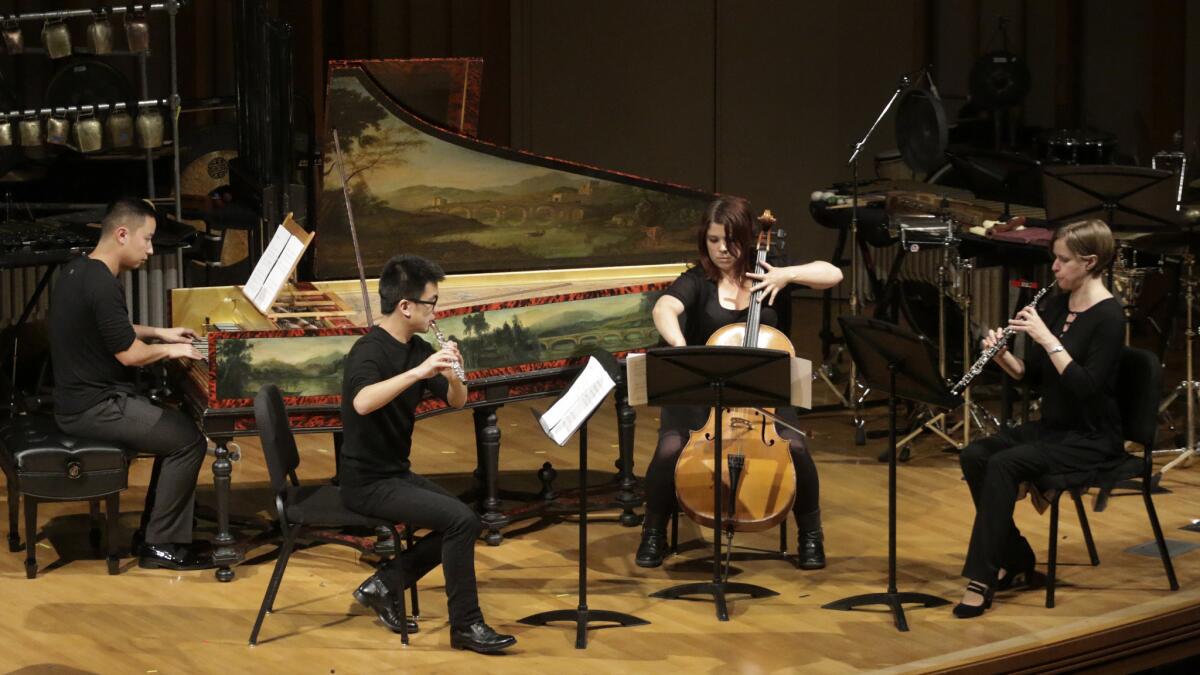Piano sonatas at Monday Evening Concerts and Piano Spheres reveal futuristic visions

- Share via
Two composers, one French and one Polish, wrote piano sonatas in 1952 and 1953 that were explosive statements of their times. Each sonata, in its distinct way, was an event, gathering musical ideas that came before and suggesting a galvanic future.
More than six decades later, that suggestion still matters, even though composers Jean Barraqué and Grazyna Bacewicz remain obscure.
A program given by the Monday Evening Concerts at Zipper Concert Hall this week took its impetus from Barraqué’s Piano Sonata. The highlight of Susan Svrcek’s Piano Spheres program the next night in the same hall was Bacewicz’s Second Piano Sonata. This was a coincidence, but it was also something more. These enduring new-music series have nearly a century’s worth of experience (the Mondar Evening series is 75; Piano Spheres is in its 21st season) of discovering or reminding us of modern works that have, in one way or another, served history. Both sonatas happen to be neglected masterpieces that have continuing meaning.
British music critic, novelist and Barraqué biographer Paul Griffiths curated Monday’s program. Although the Piano Sonata was not played, Griffiths began his program notes by explaining how much the score meant to two generations of British Barraqué devotees — Bill Hopkins, Paul Keenan and Patrick Ozzard-Low — little-known in the U.S. and whose work was the revelatory business of the evening.
In two Hopkins pieces from the 1960s — “En attendant” (for harpsichord, oboe, flute and cello) and the violin solo “Pendant” — phrases begin but never quite seem to end. Keenan’s 1996 “Cloudscapes” (for piano, clarinet, violin and cello) proved equally mercurial, modern music with layers of references. Excellent young players handled the quartets; violinist Movses Pogossian provided the stunning “Pendant” solo.
Ozzard-Low’s “Sonata: In Opposition,” which received its world premiere Monday, is perhaps the closest to Barraqué’s Piano Sonata — which has the quality of Beethoven on 12-tone steroids — in spirit if not in sound, structure or style. Barraqué was also obsessed with death and in particular its representation in German novelist Hermann Broch’s “The Death of Virgil,” and Ozzard-Low follows suit with in a death-obsessed sonata based on ancient literature. And like Barraqué, Ozzard-Low used abstract music to imply the existential states, in this case Sophocles’ “Antigone.”
Composed over a period of 19 years, this 32-minute sonata, though, is for viola, not piano. On a darkened stage, the exceptional Elisabeth Smalt moved to six different music stands, one of them behind a curtain surrounded by strings of blue lights on the floor. A vase of irises on stage represented the dead. The opposition was in the music, mournful and distant when the soloist was hidden or had her back to the audience, prophetic when she faced her listeners.
The final piece was Barraqué’s “Chant Après Chant” (Song After Song), a setting of lines from Broch’s novel and a startling evocation of death and decay. Indeed, the percussion ensemble red fish blue fish, soprano Susan Narucki and pianist Aleck Karis — vividly conducted by Steven Schick — made such continuously startling sounds for 22 minutes that it seemed as though Zipper were still resonating Tuesday evening when Svrcek walked out to begin her Piano Spheres recital.
Bacewicz’s sonata came late in her program, which began with little sonatas by Domenico Scarlatti and Lou Harrison. Harrison’s sonatas, which filter the Baroque through a lyrical 1930s experimentalism, are early examples of what became a multicultural West Coast sound.
If there was a theme to Svrcek’s program, it was the use of one kind of music to produce another. Bacewicz did this by alluding to Polish folk traditions. But Poles knew her subject was the present day.
As the first 20th century Polish woman composer of note, she was a pioneer. She was also making a brave statement of resistance by battering the neo-Classical and folk traditions the Soviets required of their composers. This was the sonata that the noted Polish pianist Krystian Zimerman angrily played at Walt Disney Concert Hall six years ago when he controversially attacked American foreign intervention.
Svrcek played the sonata with focused intensity. Her tone is direct and percussively ringing. As the piece progressed, it seemed to inevitably accumulate more and more grim force.
She demonstrated a more playful and seductive side with the first performances of three preludes by Frederick Lesemann, Svrcek’s husband. These are the final three of eight preludes (Svrcek gave the premiere of the first five at Piano Spheres last season) all based on a tenor line by the 15th century composer Guillaume Dufay. Lesemann upsets the Dufay apple cart, subtly in slow preludes and with percussive merriment in a fast one.
For recent pieces up-dating Chinese and Ukrainian folk music — the “China West” Suite by Chen Yi and “Gutsulka-dance” by Julia Gomelskaya — Svrcek was joined by percussionist Yuri Inoo. Both made a splash.
Bacewicz and Barraqué, on the other other hand, were not in the business of making a splash but making, through formidable sonatas, a difference.
More to Read
The biggest entertainment stories
Get our big stories about Hollywood, film, television, music, arts, culture and more right in your inbox as soon as they publish.
You may occasionally receive promotional content from the Los Angeles Times.











